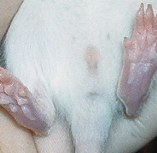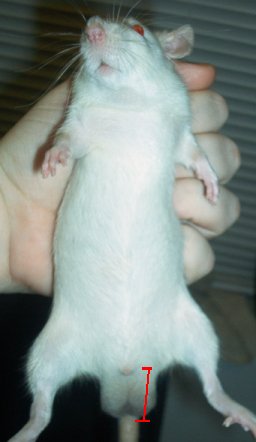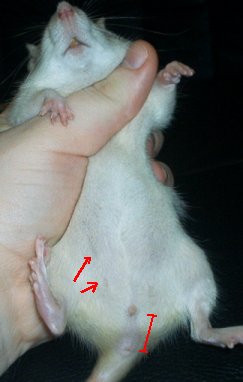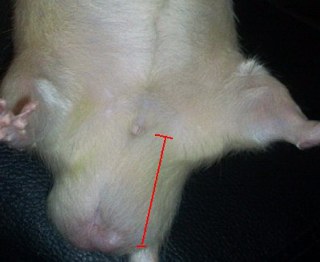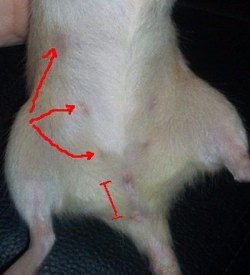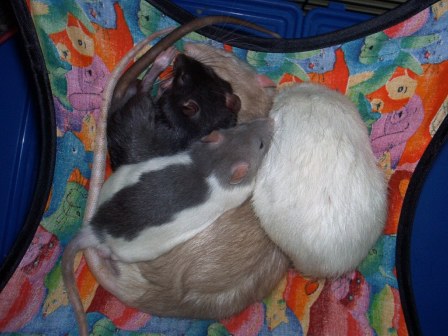Choosing Your Rats
 Where to Get a Rat
Where to Get a Rat
Pet stores are not ideal places to acquire any pet. The animals in stores are exposed to many other animals and people, which makes rats from even the best stores more likely to be stressed or sick. Many pet stores also get their rats from factory breeders (who pay no attention to health or temperament in lines), don't separate genders, and keep their rats on bedding or feed them food that is not healthy and can cause health problems later in their lives. If you must buy from a pet store, ask the owner about where they acquire their animals and make sure they are in good health and kept in good conditions.
Rats occasionally end up at a pound or in a small pet rescue. These (especially the latter) are good places to adopt rats. You can ask about the rats' personalities and will be helping an animal in need.
Reputable breeders are your best option if you want to have a healthy and friendly pet. Not all breeders are reputable, but you can ask for references and talk to people who have adopted from them before. An added bonus of adopting from a breeder is that you can see the parents' of your rats. You may also be able to adopt a rat with unusual color or type. Rats from good breeders are usually more expensive, but in the long run, you will likely save on vet bills and have a better pet overall. Rat breeders can be found by searching the internet or attending pet expos or rat shows in your area.
 Gender
Gender
There is no "better" gender.
Males tend to have a slight body odor. Their fur is coarser and often oily. Males are very laid back and will sleep on your lap. They are larger than females. Males are at a lower risk for mammary tumors (the most common form of cancer in rats). Some males do not get along with rats they don't grow up with. Males are less nervous and less likely to escape or get spooked.
Females are softer, cleaner, and smaller. They have no body odor. Female rats are slightly less allergenic than males and may be a better option for allergy sufferers. Females are at risk for tumors when they get older. They are more active (even hyper active) and playful. They are often skittish and spook at sudden movements or if a cat or dog is around. Females tend to eat less than males but need a higher percentage of protein and fat in their diet. Remember that if you buy a female from a pet store, there is a chance she could be pregnant because pet stores often do not separate genders early enough or at all.
Don't trust a pet store worker's word on the gender of a rat. You need to learn how to tell this yourself. It is very easy to tell a male from a female. Rats do not have breeding seasons like some other animals, so once they are mature, their genders are apparent. Notice different lengths of genital features, and male rats have no teats. Here are some pictures with differences indicated to help guide you:
 |
Male
|
Female
|
3 Weeks
|
|
|
6 1/2 Weeks
|
|
|
Full Grown
|
|
|
If the genders are not obvious like this either they are too young to be weaned and adopted, they haven't developed as they should, or the males are stressed (letting them walk around and relax will help their gender become more apparent ;) ).
 Age
Age
If you adopt from a breeder, age doesn't matter. Most good breeders place rats in new homes at six weeks of age. By this time, they are weaned and had all the needed socializing with siblings. Young rats may have a hereditary disease called megacolon. This disease is always fatal when the onset is early but shows symptoms and usually kills rats before they are six weeks old. If you adopt an adult, remember that rats have short life spans and you'll have less time with them. In a pet store, look for rats that don't have baby proportions (big cutesy heads) but are still young. Look for a smallish animal with a lanky rattish body. Adults from pet stores are often sickly and hand-shy; this may not be easily corrected in an adult, and an older female from a store may be pregnant.
These rats are too young to leave their mom or siblings:
These are a good age:
 Variety
Variety
Color and type are a personal preference. Despite many claims, no variety is calmer or more playful than another. Temperament can be inherited through a line of rats but it is not linked to any physical feature. The most common colors are agouti (speckled brown/black), black, beige (tan), and albino (white with red eyes) also hooded (which is white with any other color on head, shoulders and, stripe or spots down the spine). Some rarer types you may run into are blue (gray), siamese, dumbo (large, dopey ears), Rex (curly furred), hairless, odd-eyed, dalmatian, and many more. The rat shown here is a blue dumbo double Rex.
 How Many
How Many
Never get just one rat if it can be avoided. They can happily live alone but are MUCH happier and healthier in pairs or groups (both genders), no matter how much attention you give them. An ideal number for any household is 2 to 4 rats of the same gender. More than this, and you will get some dominance fights, and they'll need a considerably large cage and water bottle. Keep only as many as you have the space and time for, but never just one!


